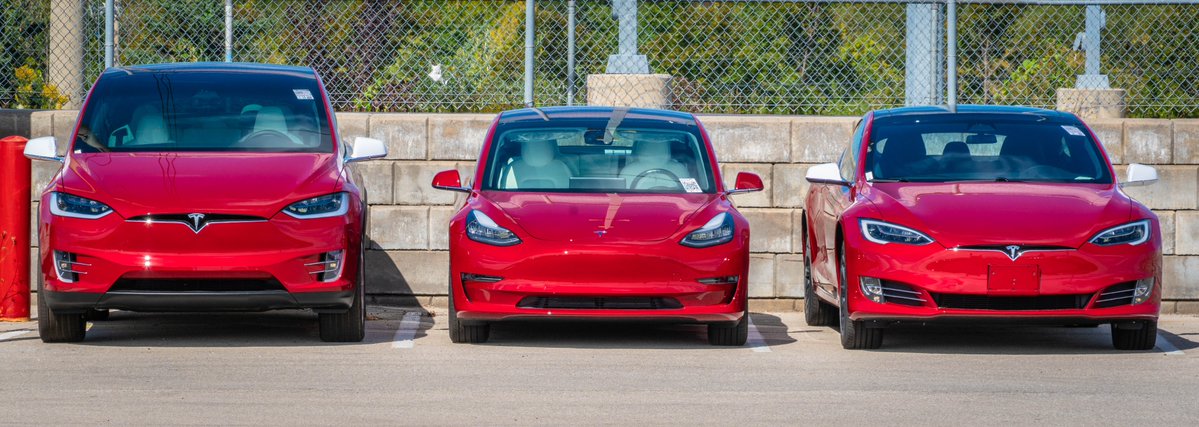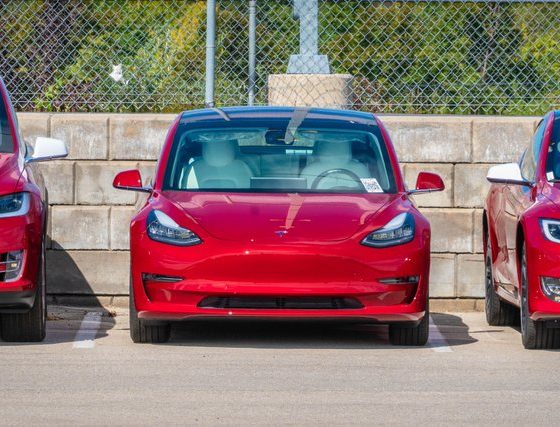

News
Tesla’s 75 kWh battery pack removal opens doors to ‘Track Mode’ for Model S & X
In a recent update on Twitter, Elon Musk announced that Tesla would be discontinuing the 75 kWh variants of the Model S and Model X. Starting this coming Monday, Tesla’s two flagship vehicles would only be offered at 100 kWh and 100 kWh Performance versions, widening the price gap between the cars and the company’s newest offering — the Model 3.
In a way, retiring the 75D line seems to be the right decision for Tesla. After all, the Model S 75D, which is priced at $76,000 before options, pretty much overlaps with the price of a fully-loaded Model 3 Performance. That said, this change also results in the base price of the Model S and Model X increasing significantly. The Model S 100D — the vehicle’s base version starting Monday — would start at $94,000, while the Model X 100D would start at $97,000, far higher than the Model X 75D’s starting price of $82,000.
Starting on Monday, Tesla will no longer be taking orders for the 75 kWh version of the Model S & X. If you’d like that version, please order by Sunday night at https://t.co/46TXqRJ3C1
— Elon Musk (@elonmusk) January 9, 2019
Apart from widening the gap between the more affordable Model 3 and the flagship Model S and X, though, the retirement of the 75 kWh battery pack also opens the doors to a very likely battery upgrade for the full-size sedan and SUV. The Model S and X, after all, are still equipped with 18650 cells, which are smaller and a bit older than the 2170 cells being used on the Model 3. These cells are also imported from Panasonic’s facilities in Japan, instead of being produced in Gigafactory 1.
By retiring the 75 kWh battery pack, Tesla would give itself an opportunity to roll out the newer cells to its flagship vehicles. The 2170 cells, for one, would probably even allow the Performance-branded Model S and X to handle extended track driving. Part of the reason behind the current generation Model S and X’s inability to be competitive on the track, after all, is their batteries, which have a tendency to overheat after a few laps around a closed circuit. This particular issue has been largely addressed by Tesla with the Model 3 and its 2170 cells, as evidenced by the vehicle’s dedicated Track Mode setting.
A Track Mode feature for the Performance Model S and X would make the vehicles even more fearsome than they already are. Even with their general inability to be driven on a racecourse, the Model S and Model X have nonetheless developed a reputation as monsters in straight-line races over the years. Equipped with a battery that has the same tech as the Model 3 — from its 2170 cells to its clever cooling systems — the Model S and X would be downright frightening.

Apart from opening the doors to Track Mode, an update to 2170 cells would likely result in more range for the Model S and Model X as well. This is something that Tesla could definitely use as a selling point for its flagship vehicles, considering that the competition, including the Porsche Taycan and the Jaguar I-PACE, are still pretty much competing against the bar set by vehicles that were created during the 18650 cell era. One can only speculate how much range a Long Range version of the Model S would have if it were equipped with 2170 cells. Perhaps even a 400-mile range? Such a scenario is plausible.
Hidden within this new update from Elon Musk, though, is something that bodes well for the company’s upcoming vehicle — the Model Y. Seeing as Tesla retired the Model X 75D, the company’s only SUV in its lineup now starts at $97,000. That’s very expensive, and this price notably reduces the size of the vehicle’s potential consumer base in an incredibly popular segment. By adopting this strategy at this point, Tesla appears to be hinting at the release of another, more affordable SUV that can compete more aggressively than the entry-level Model X. This vehicle, of course, would be the Model Y.
The Model Y has been in the rumor mill for some time now. In recent months, though, Elon Musk has provided a number of updates on the vehicle. During the company’s third-quarter earnings call, for one, Musk mentioned that he had already approved the construction of the Model Y’s alpha prototype. Musk has also joked that the upcoming SUV would be unveiled this 2018, perhaps sometime in the first half of the year.

News
Tesla FSD fleet is nearing 7 billion total miles, including 2.5 billion city miles
As can be seen on Tesla’s official FSD webpage, vehicles equipped with the system have now navigated over 6.99 billion miles.

Tesla’s Full Self-Driving (Supervised) fleet is closing in on almost 7 billion total miles driven, as per data posted by the company on its official FSD webpage.
These figures hint at the massive scale of data fueling Tesla’s rapid FSD improvements, which have been quite notable as of late.
FSD mileage milestones
As can be seen on Tesla’s official FSD webpage, vehicles equipped with the system have now navigated over 6.99 billion miles. Tesla owner and avid FSD tester Whole Mars Catalog also shared a screenshot indicating that from the nearly 7 billion miles traveled by the FSD fleet, more than 2.5 billion miles were driven inside cities.
City miles are particularly valuable for complex urban scenarios like unprotected turns, pedestrian interactions, and traffic lights. This is also the difference-maker for FSD, as only complex solutions, such as Waymo’s self-driving taxis, operate similarly on inner-city streets. And even then, incidents such as the San Francisco blackouts have proven challenging for sensor-rich vehicles like Waymos.
Tesla’s data edge
Tesla has a number of advantages in the autonomous vehicle sector, one of which is the size of its fleet and the number of vehicles training FSD on real-world roads. Tesla’s nearly 7 billion FSD miles then allow the company to roll out updates that make its vehicles behave like they are being driven by experienced drivers, even if they are operating on their own.
So notable are Tesla’s improvements to FSD that NVIDIA Director of Robotics Jim Fan, after experiencing FSD v14, noted that the system is the first AI that passes what he described as a “Physical Turing Test.”
“Despite knowing exactly how robot learning works, I still find it magical watching the steering wheel turn by itself. First it feels surreal, next it becomes routine. Then, like the smartphone, taking it away actively hurts. This is how humanity gets rewired and glued to god-like technologies,” Fan wrote in a post on X.
News
Tesla starts showing how FSD will change lives in Europe
Local officials tested the system on narrow country roads and were impressed by FSD’s smooth, human-like driving, with some calling the service a game-changer for everyday life in areas that are far from urban centers.

Tesla has launched Europe’s first public shuttle service using Full Self-Driving (Supervised) in the rural Eifelkreis Bitburg-Prüm region of Germany, demonstrating how the technology can restore independence and mobility for people who struggle with limited transport options.
Local officials tested the system on narrow country roads and were impressed by FSD’s smooth, human-like driving, with some calling the service a game-changer for everyday life in areas that are far from urban centers.
Officials see real impact on rural residents
Arzfeld Mayor Johannes Kuhl and District Administrator Andreas Kruppert personally tested the Tesla shuttle service. This allowed them to see just how well FSD navigated winding lanes and rural roads confidently. Kruppert said, “Autonomous driving sounds like science fiction to many, but we simply see here that it works totally well in rural regions too.” Kuhl, for his part, also noted that FSD “feels like a very experienced driver.”
The pilot complements the area’s “Citizen Bus” program, which provides on-demand rides for elderly residents who can no longer drive themselves. Tesla Europe shared a video of a demonstration of the service, highlighting how FSD gives people their freedom back, even in places where public transport is not as prevalent.
What the Ministry for Economic Affairs and Transport says
Rhineland-Palatinate’s Minister Daniela Schmitt supported the project, praising the collaboration that made this “first of its kind in Europe” possible. As per the ministry, the rural rollout for the service shows FSD’s potential beyond major cities, and it delivers tangible benefits like grocery runs, doctor visits, and social connections for isolated residents.
“Reliable and flexible mobility is especially vital in rural areas. With the launch of a shuttle service using self-driving vehicles (FSD supervised) by Tesla in the Eifelkreis Bitburg-Prüm, an innovative pilot project is now getting underway that complements local community bus services. It is the first project of its kind in Europe.
“The result is a real gain for rural mobility: greater accessibility, more flexibility and tangible benefits for everyday life. A strong signal for innovation, cooperation and future-oriented mobility beyond urban centers,” the ministry wrote in a LinkedIn post.
News
Tesla China quietly posts Robotaxi-related job listing
Tesla China is currently seeking a Low Voltage Electrical Engineer to work on circuit board design for the company’s autonomous vehicles.

Tesla has posted a new job listing in Shanghai explicitly tied to its Robotaxi program, fueling speculation that the company is preparing to launch its dedicated autonomous ride-hailing service in China.
As noted in the listing, Tesla China is currently seeking a Low Voltage Electrical Engineer to work on circuit board design for the company’s autonomous vehicles.
Robotaxi-specific role
The listing, which was shared on social media platform X by industry watcher @tslaming, suggested that Tesla China is looking to fill the role urgently. The job listing itself specifically mentions that the person hired for the role will be working on the Low Voltage Hardware team, which would design the circuit boards that would serve as the nervous system of the Robotaxi.
Key tasks for the role, as indicated in the job listing, include collaboration with PCB layout, firmware, mechanical, program management, and validation teams, among other responsibilities. The role is based in Shanghai.
China Robotaxi launch
China represents a massive potential market for robotaxis, with its dense urban centers and supportive policies in select cities. Tesla has limited permission to roll out FSD in the country, though despite this, its vehicles have been hailed as among the best in the market when it comes to autonomous features. So far, at least, it appears that China supports Tesla’s FSD and Robotaxi rollout.
This was hinted at in November, when Tesla brought the Cybercab to the 8th China International Import Expo (CIIE) in Shanghai, marking the first time that the autonomous two-seater was brought to the Asia-Pacific region. The vehicle, despite not having a release date in China, received a significant amount of interest among the event’s attendees.








